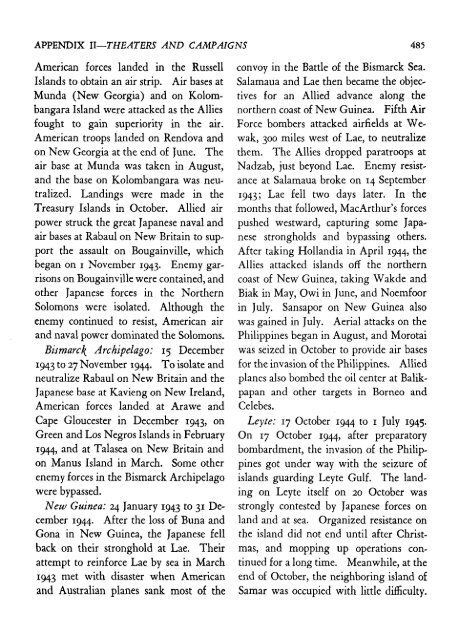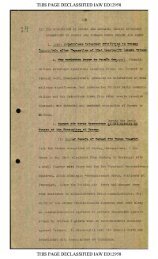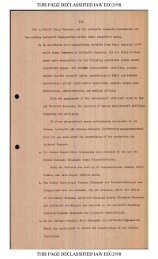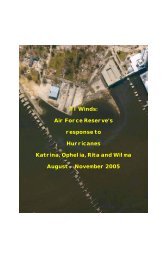Air Force Combat Units of WWII
Air Force Combat Units of WWII
Air Force Combat Units of WWII
You also want an ePaper? Increase the reach of your titles
YUMPU automatically turns print PDFs into web optimized ePapers that Google loves.
APPENDIX 11-THEATERS AND CAMPAIGNS 485American forces landed in the RussellIslands to obtain an air strip. <strong>Air</strong> bases atMunda (New Georgia) and on KolombangaraIsland were attacked as the Alliesfought to gain superiority in the air.American troops landed on Rendova andon New Georgia at the end <strong>of</strong> June. Theair base at Munda was taken in August,and the base on Kolombangara was neutralized.Landings were made in theTreasury Islands in October. Allied airpower struck the great Japanese naval andair bases at Rabaul on New Britain to supportthe assault on Bougainville, whichbegan on I November 1943. Enemy garrisonson Bougainville were contained, andother Japanese forces in the NorthernSolomons were isolated. Although theenemy continued to resist, American airand naval power dominated the Solomons.Bismarck Archipelago: 15 December1943 to 27 November 1944. To isolate andneutralize Rabaul on New Britain and theJapanese base at Kavieng on New Ireland,American forces landed at Arawe andCape Gloucester in December 1943, onGreen and Los Negros Islands in February1944, and at Talasea on New Britain andon Manus Island in March. Some otherenemy forces in the Bismarck Archipelagowere bypassed.New Guinea: 24 January 1943 to 31 December1944. After the loss <strong>of</strong> Buna andGona in New Guinea, the Japanese fellback on their stronghold at Lae. Theirattempt to reinforce Lae by sea in March1943 met with disaster when Americanand Australian planes sank most <strong>of</strong> theconvoy in the Battle <strong>of</strong> the Bismarck Sea.Salamaua and Lae then became the objectivesfor an Allied advance along thenorthern coast <strong>of</strong> New Guinea. Fifth <strong>Air</strong><strong>Force</strong> bombers attacked airfields at Wewak,300 miles west <strong>of</strong> Lae, to neutralizethem. The Allies dropped paratroops atNadzab, just beyond Lae. Enemy resistanceat Salamaua broke on 14 September1943; Lae fell two days later. In themonths that followed, MacArthur’s forcespushed westward, capturing some Japanesestrongholds and bypassing others.After taking Hollandia in April 1944, theAllies attacked islands <strong>of</strong>f the northerncoast <strong>of</strong> New Guinea, taking Wakde andBiak in May, Owi in June, and Noemfoorin July. Sansapor on New Guinea alsowas gained in July. Aerial attacks on thePhilippines began in August, and Morotaiwas seized in October to provide air basesfor the invasion <strong>of</strong> the Philippines. Alliedplanes also bombed the oil center at Balikpapanand other targets in Borneo andCelebes.Leyte: 17 October 1944 to I July 1945.On 17 October 1944, after preparatorybombardment, the invasion <strong>of</strong> the Philippinesgot under way with the seizure <strong>of</strong>islands guarding Leyte Gulf. The landingon Leyte itself on 20 October wasstrongly contested by Japanese forces onland and at sea. Organized resistance onthe island did not end until after Christmas,and mopping up operations continuedfor a long time. Meanwhile, at theend <strong>of</strong> October, the neighboring island <strong>of</strong>Samar was occupied with little difficulty.








